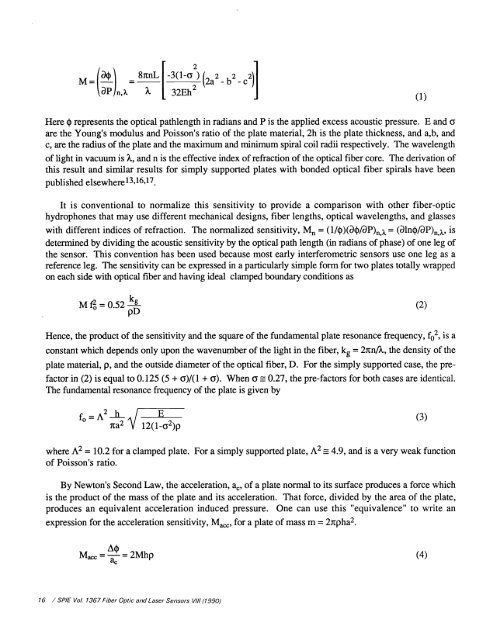A General Purpose Fiber-Optic Hydrophone Made of Castable Epoxy
A General Purpose Fiber-Optic Hydrophone Made of Castable Epoxy
A General Purpose Fiber-Optic Hydrophone Made of Castable Epoxy
Create successful ePaper yourself
Turn your PDF publications into a flip-book with our unique Google optimized e-Paper software.
M=a<br />
8icnL<br />
2<br />
- b2 - c2)<br />
(1)<br />
Here 4 represents the optical pathlength in radians and P is the applied excess acoustic pressure. E and<br />
are the Young's modulus and Poisson's ratio <strong>of</strong> the plate material, 2h is the plate thickness, and a,b, and<br />
c, are the radius <strong>of</strong> the plate and the maximum and minimum spiral coil radii respectively. The wavelength<br />
<strong>of</strong> light in vacuum is , and n is the effective index <strong>of</strong> refraction <strong>of</strong> the optical fiber core. The derivation <strong>of</strong><br />
this result and similar results for simply supported plates with bonded optical fiber spirals have been<br />
published elsewhere13'16'17.<br />
It is conventional to normalize this sensitivity to provide a comparison with other fiber-optic<br />
hydrophones that may use different mechanical designs, fiber lengths, optical wavelengths, and glasses<br />
with different indices <strong>of</strong> refraction. The normalized sensitivity, M = = is<br />
determined by dividing the acoustic sensitivity by the optical path length (in radians <strong>of</strong> phase) <strong>of</strong> one leg <strong>of</strong><br />
the sensor. This convention has been used because most early interferometric sensors use one leg as a<br />
reference leg. The sensitivity can be expressed in a particularly simple form for two plates totally wrapped<br />
on each side with optical fiber and having ideal clamped boundary conditions as<br />
M=O.52—<br />
(2)<br />
Hence, the product <strong>of</strong> the sensitivity and the square <strong>of</strong> the fundamental plate resonance frequency, f02, is a<br />
constant which depends only upon the wavenumber <strong>of</strong> the light in the fiber, kg 2ltflIX, the density <strong>of</strong> the<br />
plate material, p, and the outside diameter <strong>of</strong> the optical fiber, D. For the simply supported case, the prefactor<br />
in (2) is equal to 0. 125 (5 + c)/(1 + ). When 0.27, the pre-factors for both cases are identical.<br />
The fundamental resonance frequency <strong>of</strong> the plate is given by<br />
f0=A2J1—4F E (3)<br />
ita2 V 12(1-&)p<br />
where A2 = 10.2 for a clamped plate. For a simply supported plate, A2 4.9, and is a very weak function<br />
<strong>of</strong> Poisson's ratio.<br />
By Newton's Second Law, the acceleration, a, <strong>of</strong> a plate normal to its surface produces a force which<br />
is the product <strong>of</strong> the mass <strong>of</strong> the plate and its acceleration. That force, divided by the area <strong>of</strong> the plate,<br />
produces an equivalent acceleration induced pressure. One can use this "equivalence" to write an<br />
expression for the acceleration sensitivity, Ma, for a plate <strong>of</strong> mass m = 2itpha2.<br />
M=2.=2Mhp<br />
(4)<br />
16 / SP/E Vol. 1367 <strong>Fiber</strong> <strong>Optic</strong> and Laser Sensors Vii (1990)

















